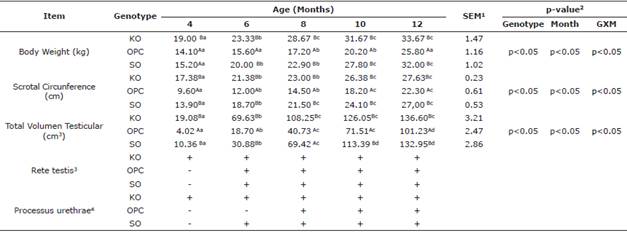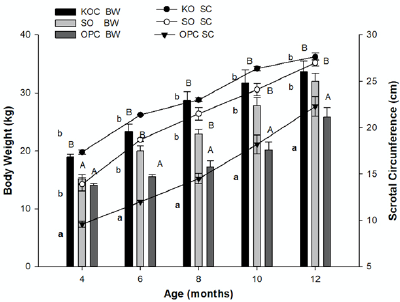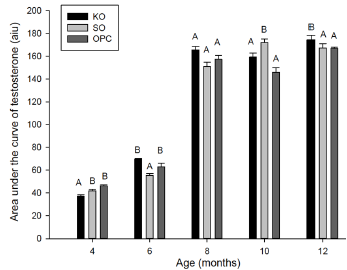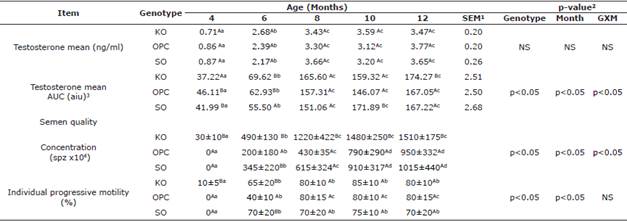INTRODUCTION
In the selection of males, the high heritability of the characteristics such as sexual precocity and fertility has great impact on the economic success of sheep farming. In general, sexual development of ram lambs appears to be more closely associated with body growth than with age. Body weight can be a better criterion for the achievement of puberty than chronological age alone [1-3]. Rate of testis growth is reported to be more rapid in lambs of highly prolific breeds such as the Finnish Landrace than in less prolific such as Awassi breed [4]. Nazari et al [3] after observing testis growth found consistent differences in the development of sexual activity and of sperm production, suggested that young ram lambs of prolific breeds (Romanov and Finnish Landrace), might differ in their future reproductive performance. The early pubertal development associated with increased body weight is desirable in terms of improved reproductive performance [5]. According to the relationship among these characteristics, selection of ram lambs at juvenile ages could improve the effectiveness of selection [6].
Puberty corresponds to the transition into adulthood and can be defined in rams as the time period when fertile spermatozoa are present in the ejaculate [7]. One of the definition is the time when rams show interest in females in estrus by successive mounting with ejaculation [2]. It is also described as the stage of sexual maturation when a ram is able to display complete sexual behavior, to produce and to release gametes [8]. According to some authors, 80% of the ram lambs show urethral process detached at the onset of puberty [9,10]. Another definition of puberty in ram lambs is based on a sustained rise in plasma testosterone concentrations (2 ng/ml) over three consecutive blood samplings performed in one week and confirmed by the presence of spermatozoa in the ejaculate with at least 30% mass motility [7,11].
Information about the onset of puberty is of considerable importance for successful reproductive management [12]. Sexual precocity and fertility provide a great impact in economical succeed of ovine herds with an increasing number of lambs per year.
Currently there is a few information available in terms of testosterone levels, semen quality, libido and sexual performance in ram lambs in a non-seasonal country at low altitude conditions [13], before this research.
The objective of this study was to assess the development of reproduction ability in terms of semen quality, morphological characteristics (testicles-penis) and plasma testosterone in young crosses of Ovino de Pelo Colombiano (OPC), Katahdin x OPC (KO) and Santa Ines x OPC (SO) ram lambs raised under low altitude tropical conditions in Colombia (Orinoquia).
MATERIALS AND METHODS
Animals and location. All procedures were approved by the University's Animal Experimentation Committee (CHEA-UdelaR). The protocol was approved by the Animal Experimentation Ethic Committee of the Facultad de Ciencias Agropecuarias, Universidad de La Salle (protocol number 141, September 2015).
The study was conducted at the experimental farm of the La Congregación La Salle located in the south east of Colombia at 04°09'12"N + 73°38'06"W and altitude of 650 m above sea level. Fifteen ram lambs, aged 3-4 months old at the beginning of the trial, from three different breeds (n = 5 per breed), where enrolled in the study until they reached 12 months of age. These animals were Ovino de Pelo Colombiano (OPC), also named "Colombian Hair Sheep", and crosses with foreign breeds Katahdin x OPC (KO) and Santa Ines x OPC (SO). The lambs were born at the farm and were selected by a selection index based on parents' genotype and phenotype. Ram lambs were raised in an all-male group. They were grazing (Brachiaria sp.), during all trial. Mineral salts and water were provided ad libitum.
Body weight, scrotal circumference and testicular volume. Every month the same operator throughout the experiment recorded these variables. Ultrasound (Pie Medical Aquila Pro VET TM) in each testicle was performed looking for the mediastinum (rete testis), indicating whether it was present or not [14].
Scrotal circumference (SC) was measured using a flexible tape at the widest scrotal diameter. The body weight was assessed using an electronic balance. The testicular volume (TV) was calculated under the formula for a prolate spheroid:
where a=testicular volume (ml), b=length of testis (cm), c=width of testis (cm) and k=scrotum thickness (0.2 cm in this experiment), of a single testicle, b and c, where derived from the calliper measurements and the total testicular volume = left testicular volume + right testicular volume [15,16].
Detachment of urethral process in ram lambs was performed retracting the prepuce and exposing the penis in order to observe this anatomical piece [9].
Assessment of semen characteristics in ram lambs. Once per month, from four to twelve months of age, semen was collected by electro ejaculation (Ideal® ElectroJac®6, Neogen Animal Safety, Lexington, KY), penis was exposed from the prepuce cavity and the urethral process was gently introduced into a conical tube to start ejaculation process. Semen was placed in a water bath at 37°C and subjected to the following tests: 1.) semen volume was measured in a conical glass tube graduated with 0.1 mL optically visible intervals; 2.) motility (semen was assessed for semen wave motion graded on a subjective scale ranging from 1 to 5, where 1 was scored when there was no mass movement and 5 represented vigorous waves of sperm motion and individual progressive motility (%), was determined according to the procedure outlined by Masoudi et al [17]; 3.) sperm concentration was determined using a standard spectrophotometer (540 nm). The proportion of normal and abnormal spermatozoa morphology was performed using the nigrosine-eosin staining by counting at least 200 spermatozoa under oil immersion objective (1000x) in random fields. Abnormal spermatozoa were then classified into proportion of spermatozoa with: head abnormalities, mid-piece abnormalities, tail abnormalities, proximal droplet, distal droplet, detached heads or tailless spermatozoa [18]. The same operator performed all examinations.
Plasma testosterone concentration. Blood samples were collected via jugular venipuncture from four to twelve months of age (every other month) during 5 hours with 45 minutes intervals (10) using heparinized venoject tubes (from 6 am to 11 am). Plasma was harvested by centrifugation at 1500 g for 15 min within an hour of collection and stored at -70°C. The concentration of testosterone in the plasma samples was measured in duplicate by using enzyme immunoassay with a diagnostic commercial kit (DS-EIA-Steroid-Testosterone RH-353, Italy). A calibration curve was used in order to assess concentrations ranging from 1.25 to 40 nmol/l of testosterone in plasma. Known samples of a mature adult ram and of an ovariectomized ewe were used as positive and negative control respectively on each plate. Lower detection limit was 0.2 nmol/l and inter-and intra-assay were 6.7% and 5.5% respectively. In each ram, testosterone curves were plotted over each 5 h period in order to determine the maximum value and the mean. Area under the curve (AUC) was also analyzed for testosterone.
Statistical analysis. Data for semen characteristics, testosterone concentration (AUC, mean), and body and testicular measurements were analysed for the effect of age (time), genotype and genotype-time interaction, using repeated measures analysis of variance in the GLM procedure. Duncan's test was used to compare means. Data are presented as means and SEM. The level of significance was set at p<0.05 for all tests. Data was analysed using SAS System (SAS version 9.12, SAS Institute Inc.).
RESULTS
The overall parameters from the ram lambs involved in the trial from 4 to 12 months of age are presented in Table 1 compiled in means and standard errors of body measurements (BW, SC, TV), rete testis, processus urethrae.
Table 1 Mean body measurements, processus urethrae presence at different months in genotypes Ovino de Pelo Colombiano (OPC) and crosses with Katahdin (KO) and Santa Inés (SO).

A,B Differences (p < 0.05) between genotype within time point. a-c Differences (p < 0.05) between time points within genotype. 1 Greatest SEM is shown. 2 P-value for genotype (G), Age (Months) and their interaction (G × M). 3 Rete testis: yes or no (+ /-); 4 Processus urethrae: detachment yes or no (+ /-).
Regarding some variables during sexual development of the ram lambs, during sixth month of age most of animals of all racial groups showed the rete testis by ultrasound, which is considered an evidence of presence of spermatozoa in this collector tube where seminal tubules deposit spermatozoa under maturation process. Something similar occurs with the detachment of processus urethrae, another evidence of sexual development during the puberty.
The table 2 includes Testosterone concentration, AUC, means and standard error means of semen quality (semen concentration, individual progressive motility), in the three biotypes of breed.
Genotype effect was significant for evolution of body development (BW, SC, TV) over time (p<0.05). Santa Ines and Katahdin crosses presented the highest values in BW during the investigation whereas OPC lambs maintained a lower value until the end of the trial; similar development was observed for scrotal circumference and testicular volume (Figure 1).

A,B Differences (p<0.05) between genotype within months to Body Weigth (BW).a,b Differences (p<0.05) between genotype within months to Scrotal Circunference (SC).
Figure 1 Relationship between age (months) and body weight and scrotal circumference of ram lambs Ovino de Pelo Colombiano (OPC) and crosses with Katahdin (KO) and Santa Inés (SO).
In this study, significant differences were observed between genetic groups (Table 1), with lower values for OPC on scrotal circumference and testicular volume (p<0.05).
Overall, the pattern of circulating testosterone was similar between the three groups, but for AUC this pattern showed significant differences for breed or time effect and interaction (p<0.05). Figure 2 shows detailed evolution of AUC over time and in function of genotype.

A,B Differences (p < 0.05) between genotype within months.
Figure 2 Age related to the area under the curve of testosterone of Ovino de Pelo Colombiano (OPC) and crosses with Katahdin (KO) and Santa Inés (SO) ram lambs.
Genotype and time effect was observed for semen quality (concentration and motility) (p<0.05). Table 2 indicates detailed evolution of these variables over time and in function of genotype.
Table 2 Mean testosterone and sperm characteristics at different months of age in Ovino de Pelo Colombiano (OPC) and crosses with Katahdin (KO) and Santa Ines (SO).

A,B Differences (p<0.05) between genotype within time point. a-c Differences (p<0.05) between time points within genotype. 1Greatest SEM is shown. 2p-value for genotype (G), Age (Months) and their interaction (G×M); 3AUC: Area under the curve of testosterone. 6 Standard deviation (±SD).
Maximum testosterone concentration and testosterone amplitude (defined in material and methods) in the three biotypes and over time showed higher values for SO crosses and OPC with higher values. This data was not included in table, instead of them the mean and Area under the curve were included because of the significant differences showed between the groups and in the period of time (p<0.05). And there were no associations between testosterone levels and semen quality or body measurements.
DISCUSSION
This study aimed to describe reproductive development in young ram lambs during the first year of life of three important hair crosses genotypes under low altitude conditions in a non-seasonal country. Determination of age of onset of puberty varies among researchers and it depends on methodologies or variables selected by investigators; hence, it is important to mention the different criteria used to determine this fundamental moment during the development of ram lambs. The presence of spermatozoa with motility in an ejaculate, the achievement of adult body weight (50 to 60%), the detachment of processus urethrae and the ability of the ram lamb to detect estrus are considered variables to determine the onset of puberty [19-22].
Daily weight gain is a determining factor in sexual development and onset of puberty in lambs and puberty is reached when the lamb achieves between 50 and 60% of its adult body weight [19]. The pure breeds Katahdin and Santa Ines are specialized beef breeds developed in the USA and Brazil, and in these herds the selection of the superior individuals has focused on the body conformation and weight, which have led to an increase in size and weight of adult animals and consequently to the reduction of their maturity age [23-26].
For this reason, the breed crosses selected for this study are based on a creole breed group, the Ovino de pelo colombiano (OPC), and its crosses with Katahdin and Santa Ines. The OPC is considered a creole breed which has had a very adequate adaptation to the region, despite not receiving genetic improvement since its arrival with the Spaniards to Colombian territory during the Conquest [27,28]. Therefore, it is important to perform crosses with improved breeds [29], such as the other two selected for this research, KO and SO lambs, which reached puberty at similar weights unlike OPC lambs with an onset of puberty at lower weight and older age, and this indicates that body weight is a relevant measure for selecting breeding animals.
Male puberty is closely related to testicular growth [6]. During this study, a significant increase in the testicular volume of the ram lambs was observed suggesting that animals were in a stage of rapid sexual development from the age of 4 months; similar results were obtained by Emsen [4], who observed the marked increased from the 90 to 180 days of age. The highest testicular volume and live weight were obtained by lambs KO and SO as the testicular volume is related to the body weight, related to the feeding of the animal [30-32]. Results of testicular volume of this study are very similar to those reported in pure breeds Awasi (A), and Red Karaman (R), from Turkey with 17.7± 2.6 ml and 21.3± 2.6 ml respectively and their crosses RxA and AxR with 23.8± 2.6 ml y 17.9± 2.6 ml respectively at 6 months old [4].
Onset of puberty is also defined by the mean diameter of the seminiferous tubules, which diverge in the so-called testicular mediastinum and is highly correlated with testicular weight [33]. The testicular mediastinum appears in the central part of the testicle as a hyper echogenic line [34], the sort of echogenicity can be involved in a score indicating clearly its presence, yes or not. Then, this anatomical appearance can be associated with presence of spermatozoa in this duct coming from the various seminiferous tubules, which could be considered as an important element to determine the onset of puberty; 80% of KO and SO ram lambs showed the mediastinum during the time considered as onset of puberty in comparison with 40% of the OPC. The presence or not of rete testis evaluated by ultrasound, was associated to the presence of spermatozoa in ejaculate.
Comparing the results of a study in Brazil with the Santa Ines breed in the determination of the onset of puberty based on detachment of the urethral process, similar results are observed between KO and SO with the Brazilian breed, while the OPC lambs reached urethral detachment with eight months of age [10]. We could observe high relation in the onset of puberty and appearance of mediastinum and the detachment of the urethral process.
Regarding all data obtained from testosterone analysis, it is observed how the concentration differs from Colombian authors previous reports [12], probably because they had only one measure in comparison with our research where the mean came from samples collected during 5 hours with an interval of 45 minutes, as this trial was designed to get at least one of the several testosterone peaks that physiologically occurs in a ram in 24 hours. Avellaneda [13] reported, with one blood collection, the following values for Colombian Mora (0.41±0.08 ng/ml), Romney Marsh (0.55±0.25 ng/ml), OPC (0.46±0.09 ng/ml) and Hampshire (1.69±0.32 ng/ml). Our results are similar with Hampshire data, being 1.3±0.1ng/ml, 1.4±0.1ng/ ml, 1.5±0.2 ng/ml for OPC, SO and KO respectively.
Another evaluation performed during testosterone analysis was the area under the curve (AUC), a parameter that could be considered very useful, as it shows testosterone levels during 5 hours, been able to obtain higher, lower and delta levels, making of this tool another much more complete way to analyze hormone concentration. These results of testosterone let conclude how all animals at eight months of age showed testosterone levels expressed in the AUC similar to adults, being able to conclude how during this time they are already young adult rams and expressing a sort of sexual maturity.
Analyzing spermatozoa concentration and individual progressive motility during ram lambs development, it was related with the increasing semen quality variables, especially since month 6 of age and increasing until ten months of age, when value stabilization occurred. Concentration and progressive motility maintained similarity until 12 months age when the trial finished and significant differences between racial groups were observed throughout the experiment (p<0.05). The KO lambs showed higher precocity in seminal quality parameters. In this study semen variables increased rapidly in a linear way, starting with six months old in general, and this was particularly observed between 7 and 10 months old, when semen variables got stable levels similar to parameters of adult rams.
In conclusion non-seasonal tropical conditions in Colombia, depending on the variables included, body weight, testicular development, pennis morphology, semen quality, sperm concentration and testosterone levels, it is postulated that around six months of age, the onset of puberty is displayed in the three biotypes. The methodology of using different reproductive variables proposed in this study in order to evaluate sexual development, prove to be an useful tool to determine lamb onset of puberty.











 text in
text in 



